This week saw a concerted effort to attempt to draw the excavations to a close so that laboratory work could proceed. As of week’s end, only 2 of the 5 excavations are still open.
West of Caana, work proceeded on fully exposing the south facing of Structure A37 (C208) and on taking out the balks between the eastern units so that a full 39 meters of the eastern side of this structure are visible. All of this was drawn by Max, Nick, Sam, and Sarah. The northeastern corner which is 30 m away from the last excavation was also excavated in a 2 m by 3 m unit. It would appear that Structure A37 was 69 m in length with one central entranceway. Next year we will fully investigate the interior of this building.
In the A36 platform (C207), we added a small 1 m by 2 m excavation to the southwest corner of the southern trench in order to find the corner of the buried building. The corner was indeed found and indicates that the frontal platform for this early building was 10 m in length at its summit. Eric and Lily recorded the southern trench and the southwestern corner during the week. We previously had encountered an early Early Classic tomb and two Protoclassic burials in the plaza fill in front of (and over) this buried construction, which was the reason for further investigation of this platform. It now appears that these burials were actually on axis to this buried platform. Next year we will clear the front of this building and excavate into its core.
In the Northeast Acropolis (C205), Mo, Shane, and George continued going further down through all of the lower floorings, finding more finger bowls as the floors were removed. Underneath Floor 2, they uncovered the outline of the side of a buried Preclassic building, complete with outer coating of stucco. This building had been constructed in association with Floor 4 and had been completely leveled down to the base stones and then buried beneath Floor 2 (Floor 3 abutted this structure). At the eastern edge of the excavation, a circular construction wall was encountered on the northern edge of the excavation beneath the lowest mid-level floor (Floor 6). In the southeastern corner of the trench, a deeper excavation was made in order to encounter the Late Preclassic building that we had encountered in 1994. With much trepidation, Jaime kept cutting closer and closer to our old trench, finally encountering the front of this structure barely 10 cm away from where we had previously stopped excavating.
In Central Acropolis (C206), Lisa and Mark finished the excavation of the tomb in the center of the plaza and we resumed excavation in the northern half of the central plaza excavation by week’s end. The tomb apparently housed a single individual with head to the south; the bones of this person were in very bad shape, but largely rested on the top of the bench in the chamber. The individual was accompanied by nine vessels, 8 bowls and a single dish with a lateral ridge. The bowls were also in extremely bad shape, as it appears that this tomb held water at certain times of the year (much like the tomb that we excavated in Structure A38 in the Central Acropolis in 1992). One of the bowls from the southern end of the chamber (off the bench in a narrow alley), upon which the head of the individual had been placed, had once been elaborately stuccoed with a pink background onto which black figures in feather headresses had been placed. The majority of the bowls, however, were red-slipped with very friable paste.
In Ultimo, Rachael, Angelica, and Carlos worked all week on excavating the tomb that was in the core of the building. The bedrock had been cut into quite deeply before they built the finely-cut rock side walls and tiered slab vault over this area. At least 6 whole and 2 partial vessels came out of this chamber as well as 3 sets of shell earrings. Lucas also did the section and noticed a possible crude stone box in section capped with a slab. Digging into this feature revealed a cache consisting of 2 finger bowls and 1 unslipped barrel.
A final excavation (C209) was dug on the summit of Structure A13 in the area where we suspected that the new altar had come from. The area showed evidence of having been filled with stone. We positioned a 1 m N-S by 1.25 m E-W excavation over this area. It was dug down through the backfill into dry core fill. Importantly, it produced the missing front piece of the monument as well as a series of chips that fit the edge of the monument, showing conclusively that this altar had indeed been located here.
At week’s end, we are beginning to transition to laboratory mode.
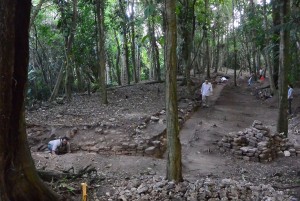
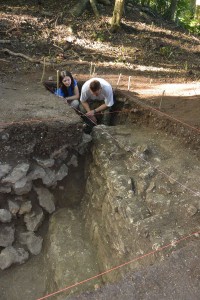
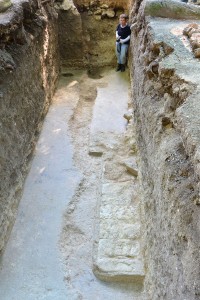
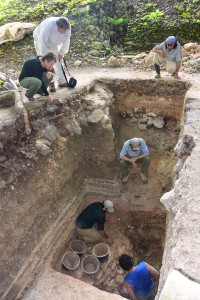
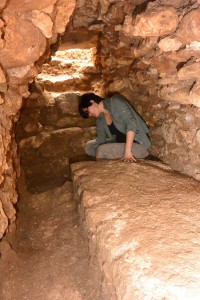
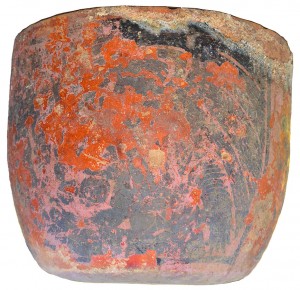
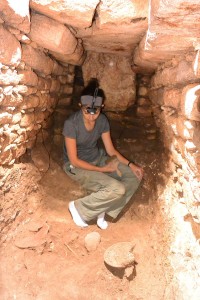
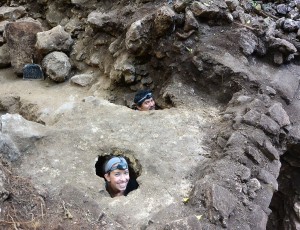
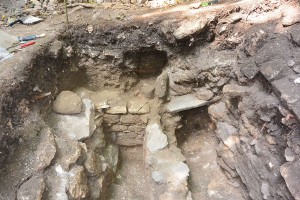
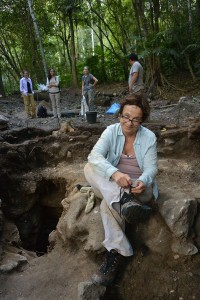
Everything looks interesting and challenging.
You guys are so talented.
Keep up the excellent work!
You guys are making great progress. The scope of this project is amazing!
Whack a mole. I love that picture